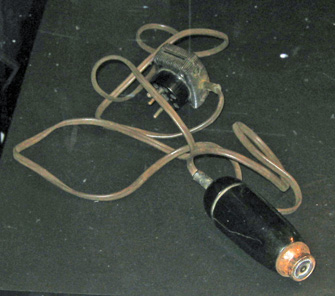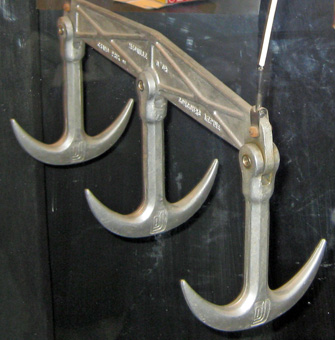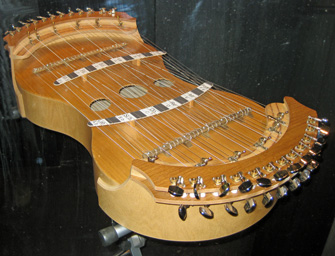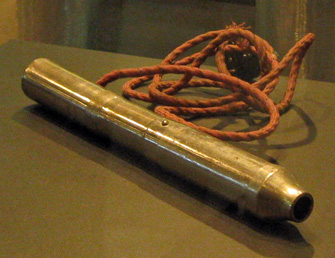 |
|
Is this the invention of the year? Etienne Bonaud playing his “didgophone,” a cross between a saxophone and a didgeridoo, at the Foire de Paris. |
There are more oyster openers on sale in Paris this week than oysters. At least that’s my impression after a visit to the Foire de Paris, the gigantic fair held at the Porte de Versailles exhibition grounds every spring (through May 8 this year). The event is vaguely like an American state fair, but with no deep-fried corn dogs to eat, no midway rides to bring them back up, and more vendors. A lot more vendors. In fact, the Paris Fair is almost purely commercial, like a trade show for every trade that has anything to show.
A lot of the space is given over to home fittings and furnishings. From toilet brush holders to four-meter-high wrought iron gates, everything for the household is on sale at the Foire de Paris – including the house, since there are also real-estate agents among the exhibitors. A homeless person who just won the lottery could walk into Pavilion 1 in the morning and come out in mid-afternoon the proud owner of a fully equipped house with an ultramodern kitchen and bathroom, multiple fireplaces, triple-glazed windows, solar heating, state-of-the-art lighting and every appliance known to science. He could then walk, or more likely stagger, over to Pavilion 7 and by closing time have purchased complete furniture suites for the living room, dining room, bedroom, guestroom, dressing room, undressing room, billiard room, rec room and rubber room, plus a gazebo, a swimming pool, a carport and a car to park in it. I didn’t see any stands for vomitorium fixtures, but I’m sure they’re in there somewhere.
Despite its heavy focus on the domestic, however, the Foire de Paris is also quite international. The Richesses du Monde section in Pavilion 4 is essentially a souvenir shop from hell, closely packed with stands from all over the world selling the sort of archetypal tchotchkes that you might buy in a weak moment on vacation and then burn for kindling when you get home. But thanks to the Foire, you don’t even have to leave town! You can get paisley scarves from India, silk skirts from Vietnam, tooled leather key holders from Morocco, sarongs from Tahiti, straw hats from Ecuador, pan pipes from Peru, incense burners from China, brightly painted figurines from every country on earth that has paint, and folk music CDs from every country on earth that has folk.
To restore mind and body after your virtual travels, you can head for the top floor of Pavilion 7, where the gastronomy section houses plenty of stands offering wine, foie gras, cheese, cold cuts and sweets from all over the country, many of which I had already seen (and written about) at the Salon de l’Agriculture last February.
After overeating, you can work off some calories by trying out the exercise machines in the fitness and wellness space on the upper level of Pavilion 5. Then, when your judgment is impaired by exhaustion, take the escalator down and have a look at the section Artisanat & Métiers d’Art, which translates literally as “Craftsmanship and the Applied Arts” but, judging from the stands I saw, is actually a quaint figurative expression for “gaudy overpriced decorative crap for people suffering from a heavily imbalanced wealth-to-taste ratio.”
But enough cynicism! There’s a section of the fair that I truly loved, sharing Pavilion 7.3 with the food: the Concours Lépine, an annual competition for inventions. Founded by one Louis Lépine 110 years ago, the contest is open to any product that has been protected by a patent. To mark the event’s centennial-dot-one, there’s a display showing past winners all the way back to 1901, when the gold medal went to
 |
|
Assemblo, Lépine prizewinner, 1901. |
the Assemblo, a children’s construction kit that looks like it would have given a closer shave than
 |
|
Philips electric shaver, Lépine prizewinner, 1935. |
the electric razor that won in 1935. It’s quite a varied collection, with gold-medal winners ranging from the purely aesthetic, like the Cantate, a musical instrument you have never heard of but that you can hear here (2007), to the admirably useful, like the artificial heart that shared the honors with a vacuum cleaner in 1937, to the purely industrial, like the new
 |
|
Wouldn’t you just love to hear the meat hook (1985) fall on the Cantate (below, 2007)? |
 |
meat-hook design that won in 1985. One of the worthiest winners was last year’s text reader for the visually impaired, which instantly converts print into speech or Braille, and one of the oddest was the Lépine laureate for 2001: a beer called Morbaz that’s brewed with seawater. Think of it: this could just well be the solution for keeping sea levels down as the polar ice caps melt.
A great many of the past winners are of the “home-convenience” variety, like this electric
 |
|
My guess is that France’s famous alleged aversion to soap and water started after somebody dropped one of these monsters in the bathtub. |
hair dryer from 1924. There’s also an early hotplate (1903), a pressure cooker (1911), a Singer sewing machine (1932), a toaster (1952), a hand-held batter beater (1955) and a carrot peeler (1999). I must admit, that last one gave me pause. Look at this contraption:
 |
|
Carrot peeler, Lépine prizewinner, 1999. |
Two questions here. First off, why did it take until nearly into the 21st century to develop a lousy carrot peeler? And secondly, who has the space in their kitchen for an apparatus the size of an industrial lathe but that’s in fact a lousy carrot peeler?
The Concours Lépine seems to be very popular, judging from the number and diversity of the entrants’ stands. Like the past winners, the contenders this year include lots of medical innovations, like an insulin and carb calculator for diabetics and a modified scooter-like contraption for people with reduced mobility, and of course more homeware gadgets, like clothes-hanger organizers, a plastic spout for food cartons and an incredible number of the above-mentioned oyster openers. One of them looks like a pair of tongs that could be used interchangeably for barbecuing or surgery, one looks like a bench vise, another is battery powered, and there’s an orange plastic thingy with a metal poker poking out of the middle that looks more like a sex toy than a kitchen appliance (“Equally convenient for the right or left hand!” says the blurb).
Then there’s a whole category of large-scale industrial installations so unwieldy they can only be displayed as explanations on posters. Here’s a sampling:
• A system with low noise emissions for ventilating buildings
• A system for generating energy from the pressure of vehicle tires on a roadbed
• A system for the reuse of waste keratin from the poultry industry for the production of novel polymer biocomposites
• A method for the formation of a signal recording the position of the steam valve of a bypass cooling/pressure-relief station of a high-pressure steam turbine with intermediate overheat
That last one is real, by the way, its description translated verbatim from the French. I personally think that it’s not a very original idea — the inventor is obviously just trying to cash in on the wild success of the now-famous method for the formation of a signal recording the position of the steam valve of a bypass cooling/pressure-relief station of a high-pressure steam turbine with advanced overheat.
One of the least technically sophisticated entrants is a thing called the “Crazy Goat” that seems to be a kind of a modified seltzer bottle that spurts out drinkable goat cheese, although the brochure is rather sketchy on what it actually does. Why anyone would want to drink foamy goat cheese is equally unclear. Maybe it’s actually a sex toy.
But my absolute favorite is a device that solves a dire problem that has been hampering humankind’s capacity for happiness since time immemorial: visible brassiere straps. The product is called the Clip Top, which is French for “top clip,” and it’s a butterfly-shaped hunk of plastic designed to hold bra straps in an X in back so they don’t drift out beyond the fabric frontiers of a tank top. There’s a before and after photo here, and a shot of the actual device here.
How the user is supposed to affix a clip in the middle of her back, how it’s not going to hamper her capacity for respiration once the straps are pulled together, how it’s not going to hurt when she leans back in a chair and how it’s not going to make an unsightly lump under filmy material are not discussed in detail in the documentation. Another thing I found kind of strange about the Clip Top is that the two sales reps manning the stand were both paunchy, thin-haired late-middle-aged guys. In other words, they looked like me. In other-other words, not exactly the kind of person that skimpy tank top wearers are dying to talk to about their underwear issues.
Since I seemed to fit the company profile, I volunteered to lend them a hand, but they told me to get lost. Too bad, because I already had my pitch formulated: “Excuse me, Miss, would you like me to make your brassiere disappear? Are you sure? I really think you should try it. Believe me, it’s great. How do you know unless you… Hey, come back!”
I would have generated a lot of business — for the guy two stands further down the aisle selling tear gas pens.
For actual information about the Foire de Paris, visit the fair’s site.
© 2011 Paris Update
FavoriteAn album of David Jaggard’s comic compositions is now available for streaming on Spotify and Apple Music, for purchase (whole or track by track) on iTunes and Amazon, and on every other music downloading service in the known universe, under the title “Totally Unrelated.”
Note to readers: David Jaggard’s e-book Quorum of One: Satire 1998-2011 is available from Amazon as well as iTunes, iBookstore, Nook, Reader Store, Kobo, Copia and many other distributors.
